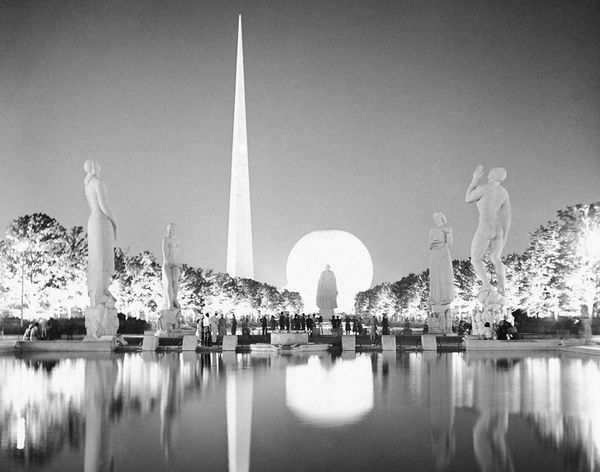1939 New York World's Fair
"1939 New York World's Fair"
The 1939-40 New York World's Fair, Flushing Meadows-Corona Park (also the location of the 1964-1965 New York World's Fair), was one of the largest world's fairs of all time. Many different countries around the world participated in it, and over 44 million people attended its exhibits in two seasons. The NYWF of 1939-1940 allowed all visitors to take a look at "The World of Tomorrow."
 Main article: World's Fair
Main article: World's Fair
"The eyes of the Fair are on the future -- not in the sense of peering toward the unknown nor attempting to foretell the events of tomorrow and the shape of things to come, but in the sense of presenting a new and clearer view of today in preparation for tomorrow; a view of the forces and ideas that prevail as well as the machines.
To its visitors the Fair will say: "Here are the materials, ideas, and forces at work in our world. These are the tools with which the World of Tomorrow must be made. They are all interesting and much effort has been expended to lay them before you in an interesting way. Familiarity with today is the best preparation for the future.'" -- official New York World's Fair pamphlet.
Lama Temple Girlie Show
The Bendix Lama Temple was a replica of the 1771 Potala in Jehol, Manchuria brought back by the explorer Vincent Bendix as shown in.
The Temple contained a girlie show. The 19 year old barker Herbert I. Taffae delivered the following spiel at the 1939/1940 World’s Fair and repeated for recording in 2007. Mr. Taffae went on to serve in the U.S. Army Air Corp from 1942-1945.
- It might sound strange and a trifle incongruous having lovely girls in front of the million dollar temple of Jehol whose gold leaf roof you can see over the top of this façade, but the fact is that we have a girlie show in here and a good one.
- The author of the book, Forbidden Tibet, Horizon Hunters and technical advisor of the picture, Lost Horizon, he doesn’t want his good name associated with this scandalous enterprise as brought back from the land of the lost horizon, those Terpsichordion aphrodisiacs, the love temptation dancers from the lamaseries of Tibet. A lama is a Buddhist priest and as such he must remain celibate. He must be deaf to the calls of the flesh, immune to the pangs of Passion, and adverse to the charms of beautiful women. In other words he must not marry or anything.
- Once each year he is given a test. The questions of which are the unquestionable figures of questionable young ladies, courtesans brought from the outside world to corrupt the young lama and seduce him from his holy way of life.
- Now ladies, this show has been approved by Good Housekeeping, but in case a stray moron seeking a racy spicy girl show is in this otherwise obviously intellectual audience, he too can go in there and not know the difference, but you, you lovers of art will surely recognize this show to be the apogee of oriental choreography.
- The whole thing rises to a climax when Sasha and her hilarious horde of vivacious vestal virgins unite in that unclad climax, that orgiastic ecstasy at the tail end of our performance, the passion dance of love. It’s terrific. Now once inside sit down as long as you like and admire the bare beautiful temple but those beautiful bare forms and they I say are not too formal. Go on right away. This being the first show of the afternoon I am going to cut the price of admission in half.
- Everybody goes.
Aquacade
The Billie Rose Aquacade was put on in a special amphitheater seating 10,000 people and included an orchestra to accompany the synchronized spectacular swim show. It featured Johnny Weismuller and Eleanor Holm, two of the most celebrated swimmers of the era, and dazzled fairgoers with its lighting and cascades and curtains of water, pumped in waterfalls at 8,000 gallons a minute. The cost of admission: eighty cents.
See also Esther Williams
Transportation
A special subway line, the IND World's Fair Railroad, was built to serve the fair. World's Fair (now Willets Point-Shea Stadium) station on the IRT Flushing Line was rebuilt to handle fair traffic on the IRT and BMT. A Long Island Rail Road station (now Shea Stadium) was built next to the Flushing Line station.
Closure
The fair was open for two seasons, from April to October each year, and was officially closed forever on October 27, 1940. To get the Fair's budget overruns under control before the 1940 season and augment gate revenues, the fair management in the second year replaced Whalen with a banker, Harvey Gibson, and placed much greater emphasis on the amusement features, and less on the educational and uplifting exhibits. Countries under the thumb of the Axis powers in Europe, e.g., Poland, Czechoslovakia, and France, ran their pavilions in 1940 with a special nationalistic pride. In both seasons, the only major world power that did not participate was Germany.
The great fair attracted over 45 million visitors and generated roughly $48 million in revenue. Since the Fair Corporation had invested 67 million dollars (in addition to nearly a hundred million dollars from other sources), it was an economic failure, and the corporation declared bankruptcy.
- Also see the page [ 1939 New York World's Fair ] on Wikipedia
External links
- Tour of the 1939 World's Fair
- Images from the '39 NY World's Fair
- Welcome to Tomorrow
- Iain Baird (Television Historian), Television in The World of Tomorrow
- http://www.nytimes.com/specials/magazine3/items.html
- The New York World's Fair Community
- nywf64.com (1964/1965 New York World's Fair Website)
Main article and index is at World's Fair |

|
What links here • References and Sources • Help • Contact Info
